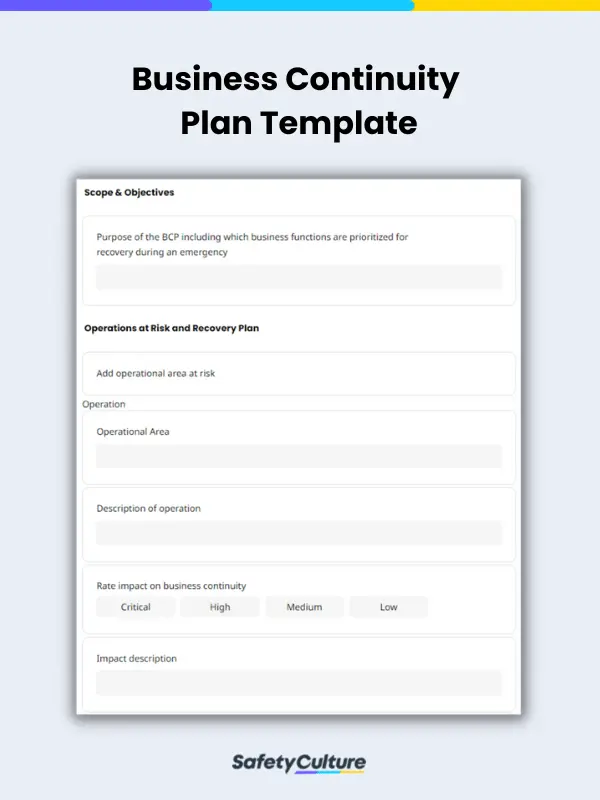What is a Business Continuity Plan Template?
A business continuity plan template is a tool used by business continuity managers and IT teams to outline strategies for keeping businesses operational despite emergencies such as extreme weather events, building evacuations, power outages, etc. It identifies high business impact operational areas, assets, and recovery strategies with assigned personnel. Business continuity templates can be used in any industry for IT disaster recovery, continuity of customer-facing operations, and backup of transport and logistics operations.
Why Use a BCP Template?
Business continuity plan templates help organizations protect their business amid a crisis or emergency. This ready-to-use document provides a structured framework, ensuring the plan is comprehensive and no essential detail is overlooked. It is also typically customizable, allowing businesses to modify them according to their specific needs.
- Seamless Recovery/Restoration Process – In the face of a crisis, time is of the essence. A BCP template expedites the recovery and restoration process by providing a predefined framework. This ensures that businesses can bounce back swiftly, minimizing downtime and preserving essential operations.
- Proper Documentation – Effective documentation is the cornerstone of a robust BCP. The template guides businesses in creating comprehensive documentation, ensuring that every aspect of the plan is clearly articulated. This not only aids in swift implementation but also facilitates better understanding among stakeholders.
- Compliances – Adhering to regulatory requirements is non-negotiable for businesses. A BCP template takes the guesswork out of compliance by integrating necessary measures into the plan. This not only safeguards the business but also ensures that legal obligations are met. Here are some general examples of compliance considerations that may be included in a BCP template:
- Regulatory Compliance – Ensure that the BCP aligns with relevant industry regulations and standards, such as ISO 22301, NIST SP 800-34, or industry-specific guidelines.
- Data Protection and Privacy – Address data protection laws and regulations, such as GDPR (General Data Protection Regulation) or HIPAA (Health Insurance Portability and Accountability Act), to safeguard sensitive information during a continuity event.
- Legal and Contractual Obligations – Include provisions to comply with legal and contractual obligations, ensuring that the organization’s commitments to clients, customers, and partners are maintained even during disruptions.
- Health and Safety Regulations – Incorporate measures to comply with health and safety regulations to protect employees and stakeholders during emergencies or disasters.
- Communication Requirements – Define communication protocols and reporting mechanisms to comply with regulatory expectations for timely and accurate communication with internal and external stakeholders.
- Financial Regulatory Compliance – Address financial regulatory requirements to ensure the organization’s financial processes are maintained and comply with relevant laws
What to Include in a Business Continuity Plan Template
Here’s a Business Continuity Plan report example:
BCP serves as a guide for organizations to create an effective strategy for responding to potential business-disrupting events. Here are four key components of a BCP:
Scope & Objectives
States the purpose of the BCP, including specific business functions that should be prioritized for recovery during an emergency. This section should include examples of emergency events that would trigger the response of this BCP.
Operations at Risk
Includes possible risks with key operational functions which would greatly disrupt business and customer continuity. This also involves the magnitude of risk to each function, which will help the BCP committee decide on appropriate preventive actions.
Recovery Strategy
Outlines all the relevant procedures to restore business operations after an incident or crisis. A good recovery strategy includes a realistic recovery timeline and essential emergency resources.
Roles & Responsibilities
Refers to key personnel and their assigned tasks during or after an incident. Each committee member has a unique set of responsibilities to successfully carry out the BCP for each business function.
FAQs about BCP Templates
BCP documents should be updated regularly. If any organizational changes have been made in terms of team structures and operational procedures, the BCP should be updated. A review will be conducted to check if the information in the BCP is still reliable.
Outdated BCPs might result in a loss of customer trust, huge revenue loss, and damage to brand and company reputation. This is why it is crucial for BCPs to remain up-to-date. Regular BCP audits are essential to help evaluate emergency procedures and identify if there are vulnerabilities.
A business continuity plan template typically includes detailed information about the plan’s scope and objectives, the operations or functions that might be affected and the risks associated with them, recovery strategies for uninterrupted operations, and the specific roles and responsibilities of essential personnel during and after an incident.



